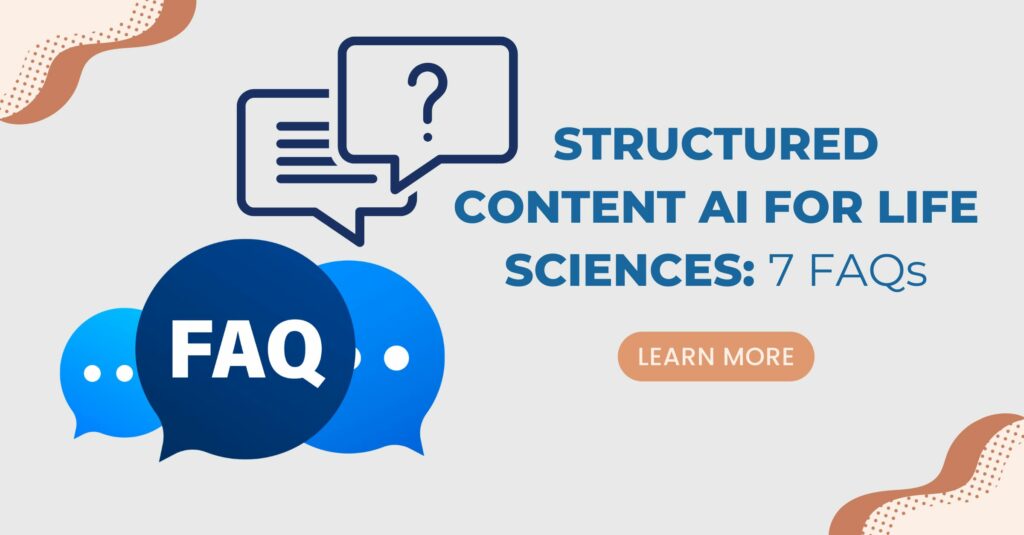
Each year, Life Sciences companies produce and manage large quantities of regulatory and patient-facing content. To meet compliance standards, ensure patient safety, mitigate risks, and reduce go-to-market cycle times, pharmaceutical companies are continually looking for new technologies and processes to streamline workflows, reduce complexity, and reuse content efficiently.
One such technology that has been making waves across the industry is Structured Content AI. Below we explore the ins and outs of Structured Content AI – including what it is, how it works, and why it can help pharmaceutical companies – by exploring 7 frequently asked questions.
FAQ #1: What is Structured Content AI?
Traditional structured content authoring is the practice of organizing and creating content in a structured way using a predefined set of rules, templates, and guidelines, along with controlled ways to reuse prior or pre-existing content and to pre-populate key elements.
Layering on AI allows for document automation, where outputs are automatically produced, built from reused components, and instantaneously populated with data. Incorporating AI into traditional structured content authoring also allows for the more efficient extraction of meaningful data and other information.
FAQ #2: How do Structured Content AI tools work?
Structured Content AI tools overlay existing content management and labeling systems to harmonize agency-neutral content with meta-data, attributes, and properties to create modular controlled components and data-driven documents at the section level. These controlled components can then be used to create a library of words and phrases that are automatically applied in the content creation and translation processes.
Using a structured content approach enables teams to break down their content pages into reusable modular components; instead of building new content models for every content page, teams build bite-sized component blocks that when put together can form any number of content pages.
Leveraging a component content management system can also allow content teams to manage, duplicate, link, and package components into individual or multiple outputs as well as to make changes to and review specific parts of a submission without having to spend multiple cycles updating and reviewing the entire document. Any changes made to a given component in the source document are automatically implemented across the other files containing that component, enabling greater security, accuracy, and flexibility.
The impact analysis and traceability features also allow you to spot-detect any regulatory submission containing a changed component so you know exactly which outputs need Health Authority interaction or re-submittal.
FAQ #3: What are the Life Sciences Use Cases for Structured Content AI?
There are numerous use cases for AI-powered structured content authoring that span regulatory, clinical, and safety functions. The advent of data standards initiatives and requirements, such as IDMP and PQ-CMC, have motivated pharmaceutical companies to take a more data-centric approach to document authoring.[1]
One of the biggest use cases for Structured Content AI is pharmaceutical global labeling. Once components are created via crawling the existing labeling ecosystem, structured content AI tools index your data based on keywords and phrases. Keywords and phrases are in turn indexed based on their usage count in outputs. Labeling teams can then select and mark certain phrases (i.e., those that are simple and easy to understand) as recommended phrases to be applied to future labels with higher priority.
Prebuilt templates for all of your regulatory outputs combined with the drag-and-drop functionality native to structured content AI tools also reduce label format generation from hours to minutes, and mapping can be automated for an even faster process.
Structured Content AI tools are additionally capable of interfacing with artwork management systems (LIFT AMS, InDesign), eliminating the need for a graphic designer or label author to spend non-value-add time manually moving graphics, illustrations, or images into a label.
Other common, high-value life sciences use cases include CMC Authoring, Safety Reports, Clinical Protocols, Labeling, Medical Writing, and Regulatory Submission Documents.
FAQ #4: What are the benefits of Structured Content AI?
Structured content AI can streamline the way pharmaceutical companies draft and manage regulatory documents. A recent study found that combining existing structured authoring and component content management systems (CCMS) with innovative, industry-specific AI tools can help reduce the time it currently takes pharmaceutical companies to develop and revise product labels by up to 50%, significantly impacting patient safety and outcomes.
Additionally, industry-tailored, and AI-enabled content management tools can mitigate the risk of manual errors, increase productivity by decreasing delays between steps, and help the team better understand how and why content was rendered over time.
In addition to reducing manual and lower-value-add efforts across content development and regulatory teams, incorporating AI can also elevate overall team capabilities by driving a higher level of skill and efficiency in performing work.
For example, structured content AI tools can crawl the labeling ecosystem to understand the content and context of data (regardless of what language it is in), providing actionable insights that would have been nearly impossible to uncover through manual processes. Instead of spending time copying and pasting, content development teams can act upon those insights to achieve sustained quality and compliance, reduce costs, and even improve patient safety and outcomes.
FAQ #5: Can Using Structured Content AI Tools Improve Quality of Submission?
The short answer is yes. Structured Content AI tools are perfectly suited to be put to work in lower-level routine tasks that are repetitive and take place within a closed management system. In such a system, the rules of the game are clear and not influenced by external forces. As the activities associated with pharmaceutical content development are repetitive (think, for example, of the cutting and pasting associated with transforming Core Data Sheets and label artwork to local label formats) and subject to rigid procedures optimizing efficiency and productivity, AI tends to perform faster and more accurately than content development teams.
FAQ #6: Can Structured Content AI tools handle both structured and unstructured data?
Yes, structured content AI tools can recognize and componentize both structured data (i.e., XML files, Excel files, and other data formats or systems) and unstructured data (i.e., charts and images).
FAQ #7: Do Structured Content AI tools make professional writers and editors obsolete?
While pharmaceutical companies can increase productivity, ensure sustained compliance, and improve quality through employing structured content AI tools, they cannot realize the full benefits of the system without keeping a “human in the loop.”
Structured content AI tools are great at doing things like crawling the labeling ecosystem to understand the content and context of data, ingesting documents, and transforming and translating unstructured data into narratives for local geography labels, but they require human intervention to select reference documents and review outputs from automation, for example. In other words, the introduction of AI into content creation processes is not meant to replace humans, but rather to empower them.
Interested in introducing AI to your labeling workflows? Contact Glemser today to get started.
[1] “https://www.fda.gov/industry/pharmaceutical-quality-chemistry-manufacturing-controls-pqcmc/pqcmc-and-idmp”>PQ/CMC and IDMP | FDA


